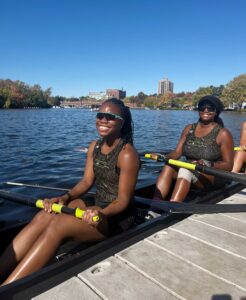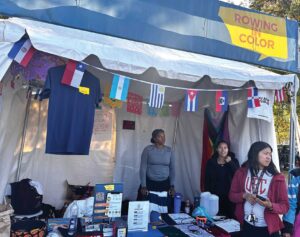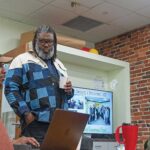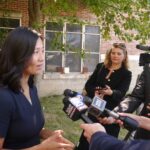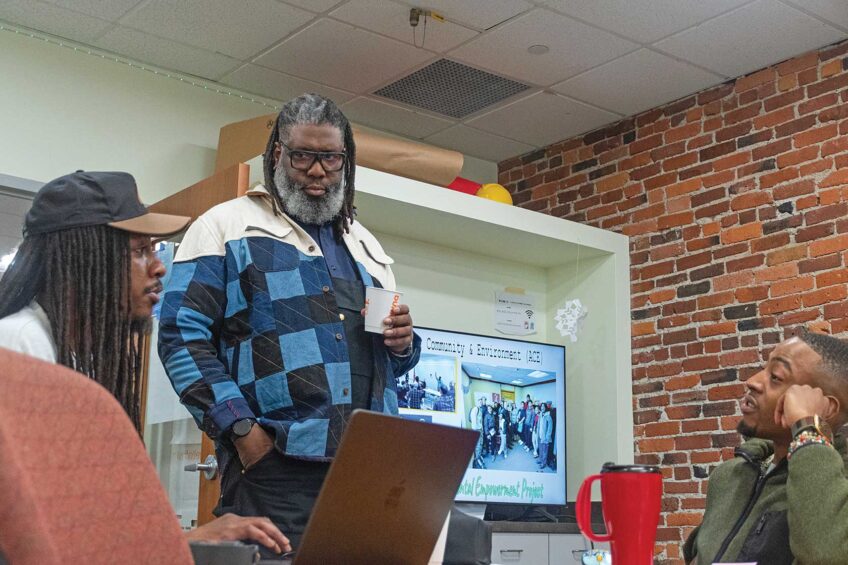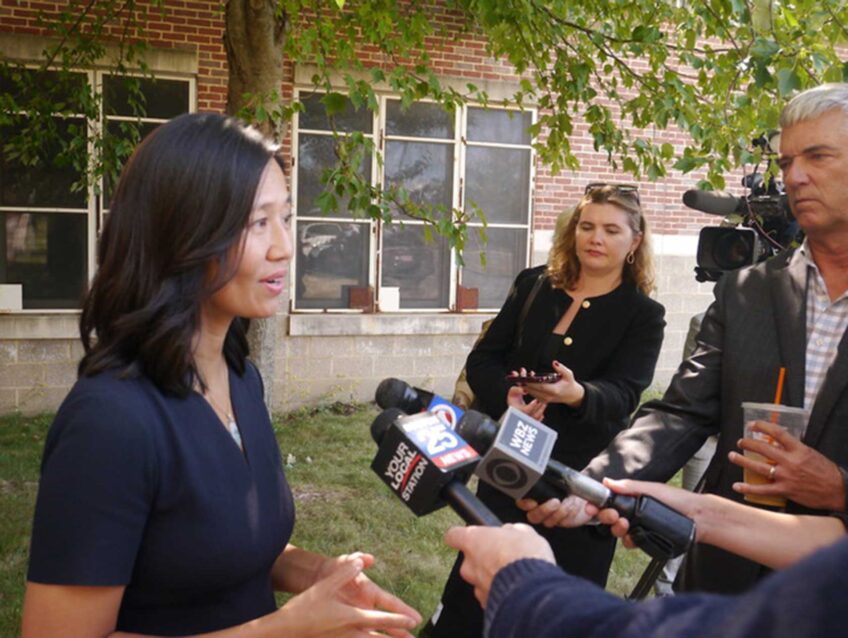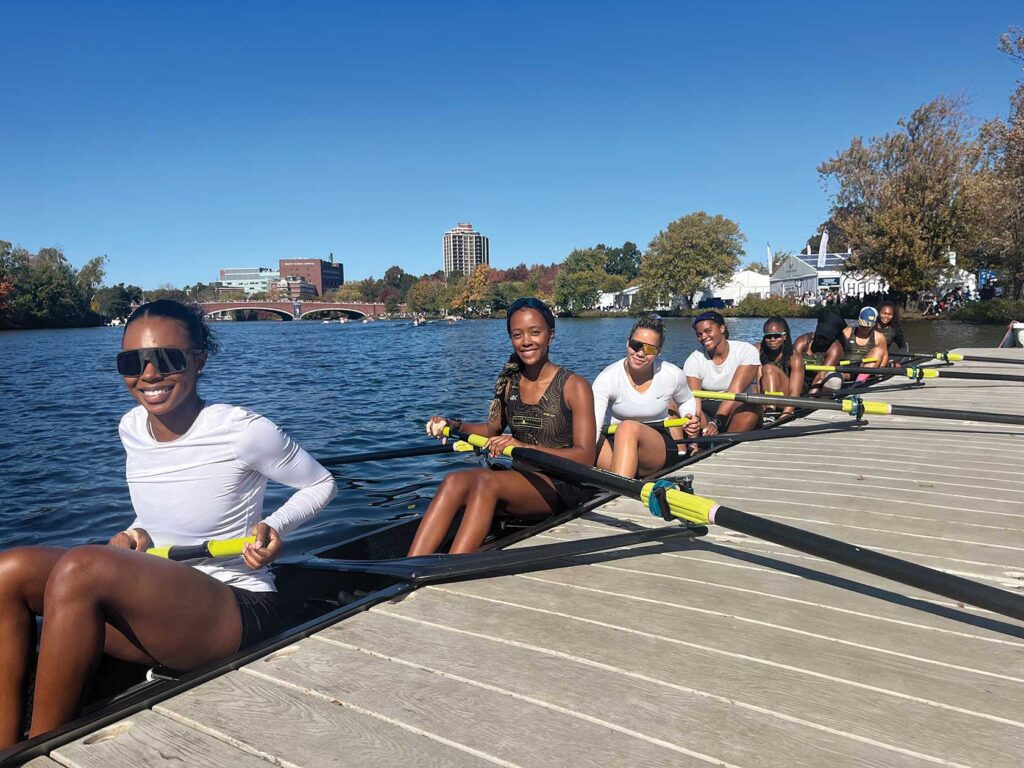
Banner Sports Sponsored by the Patriots Foundation
This past weekend, the 59th Head of the Charles Regatta was celebrated in Cambridge and was full of rowers from across the country and the world. However, with all of the mesomorphic athletes racing over the three-mile course, there was one unique group of competitors who were racing on this warm sunny day. The rowing group is called Rowing in Color and is fielded by, in this case, women of color from all over the world.
Historically, rowing has been near the bottom in diversity, fielding teams which were 77% white, according to a 2021 NCAA study on race and gender in the sport. With 2% of the athletes identified as Black, 3% Asian and 5% Hispanic, rowing ranks in the bottom third of diverse sports, of the 45 NCAA sports in the poll.
Rowing in Color is making a change in the demographic. The group was started in 2020 by Denise Aquino and Patricia Destine, seeking to give a voice and a chance to BIPOC rowers eager to compete on the world stage.
Further, Aquino felt that her ideas were not being acted upon in the majority rowing community. “Four years ago, I was working in a rowing organization, and even though I moved up in the ranks in terms of leadership and in terms of having a seat at the table, I didn’t feel heard,” she said, adding, “Well, if they’re not gonna listen to me, I’m just gonna build my own table, build my own microphone and pass it around.”
That idea in January of 2020 turned into the Rowing in Color Podcast.
“We only expected 20 downloads, 20 listeners, and then six months later, we got a lot more than 20. And to date, we have over 30,000 downloads, listeners in over 170 countries,” said Aquino.
This idea has turned into a boon for RIC, with athletes connecting and competing for a chance to row in Cambridge.
“For the last three years, we’ve been fortunate to put out boats full of people of color at the Head of the Charles,” said Aquino.
Alexa DaSilva, a coxswain based in the UK, is one of the international members of the group. She was influenced by her father who raced in college.
“My father was a bowman for his college (Cambridge) and then switched to coxswain, and so he’s always been encouraging me to get into it,” said DaSilva.
As a Londoner, DaSilva competed on the Tideway stretch of the Thames River in London, where Oxford and Cambridge do their boat racing. “I heard the podcast, and I kept in touch with the other women by emails and texts and took a six-hour flight to get here. I’m Latin. This is the first time that I’ve been in a boat with other people of color. They’re completely, a boat full of color,” she said.
Alisson Galay is another athlete who hails from the Dominican Republic. She emigrated three years ago and was involved with a rowing program run by one of Rowing in Color’s founders, Patrica Destine.
“I competed in the U17, U19 and U33 groups. It’s very competitive and it helped me to compete on my country’s national team, and it got me a lot of college offers,” said Galay. Her first victory was the key to her passion. “That first victory not only represented a sporting achievement; it was the spark that ignited the flame of my love for rowing,” she said.
The Head of the Charles is one of the premier rowing races in the country and is the biggest three-day event in the world, with over 11,000 athletes competing in 73 events. The 4800-meter course is very challenging and longer than most national, collegiate, world and Olympic sprint competitions, which are half as long.
According to US Rowing, the HOCR is a Head Race.” Head Races, which are generally held in the fall, are about 2.5-3 miles long and the boats start in their respective divisions separately at prescribed intervals (usually 10-15 seconds). They are usually conducted on a river with an assortment of bridges and turns that can make passing quite interesting. The winner is the crew that had the shortest elapsed time between the start and finish lines, with any additional time included for penalties.”
One person who has experience with this race is Zoë Bishop, an Oregon State University rower who has been rowing for many years.
“I think this will be my 10th year rowing. I rowed at the Charles one time before when I was in high school, which is an awesome experience, Bishop said. “I’m from Georgia, so I raced with the Atlanta junior rowing association.”
She considered herself lucky to be chosen for this race because “they had a record number of people who said they wanted to be involved.” She has seen the dearth of people of color in the sport, and at one time, she says, “collegiately I knew almost every single person of color that was rowing.” But she says when she visited the Metro Atlanta area four years later, she saw a change in the sport and its exponential growth in diversity.
Bishop coaches middle-school rowers now and it’s another reason she wants to be part of the Rowing in Color team so she can now tell her students, “There are other people of color like you doing these some things and coming to places like this, racing, and being competitive.” Many of the rowers have host families who put them up for the weekend. Some travel with their former college teams, and others, like Alexa, have family members who travel with them and are staying in a variety of accommodations.
Levita Robinson rowed for her Wellesley College team, but since that time has taken up the sport recreationally.
“It’s great because, even years later, I can pick back up on it, you know, you can continue racing, well into your eighties,” she said, adding, “They have categories for seniors in the eighties plus category. So, we were like, we want to be able to do that at some point in the future.”
She, too, has seen a change in the “hue” of the sport. “Years ago, I would go to these big high school championship regattas and there may be one other person like me that was there,” said Robinson. “And so now, seeing that the sport has grown. I mean, there’s still room for improvement to get more people introduced to it. But just seeing how there’s been more diversity introduced to this board is great.”
Her boatmate Adrien Reidy rowed at the University of Buffalo and she has stayed active in the sport in many different ways.
“When I graduated college, I started coaching for local teams, coached juniors and masters up in Buffalo. I’m a physical therapist. I have my own clinic where I treat rowers. I’ve combined my job with my love of rowing,” said Reidy.
They both are excited to row with other women of color from all over the world.
“It’s so exciting to see,” said Reidy. “I see other girls who look like me and, I feel yeah, okay, let’s get at it! let’s do it together. And that’s just reaffirming to them and me.”
While some rowers enjoy the comradery of the event, Sebastiana Lopez and Ulyssa Mata Ponce’s focus is slightly different. Both women can trace their roots to indigenous tribes in Mexico, the Tarahumara tribe, and the Mesoamerican people. They are part of an all-Indigenous boat at the regatta.
“Representation is as important as speed,” Ponce said. Born in Chihuahua, Mexico, and raised in Oklahoma, she looked for a coach that would “amplify that message and emphasize voices of color in this predominantly white world.” She is now a rower for Purdue University and helps fundraise for rowing clubs nationwide.
Lopez, from Queens, New York, started rowing in eighth grade by finding a club she could attend.
“We didn’t have the best equipment or the steadiest boats, but my teammates made it work,” she said. That club helped her to her goal of rowing in college. She is a graduate student-athlete coxswain for Temple University in Philadelphia.
Aquino sums up her Rowing in Color project this way: “I’d just love to create more sustainability in the work that we’re trying to do here … So that it continues, regardless of whether or not we’re involved or regardless of the size of the platform. Just really, you know, passing the mic.”

